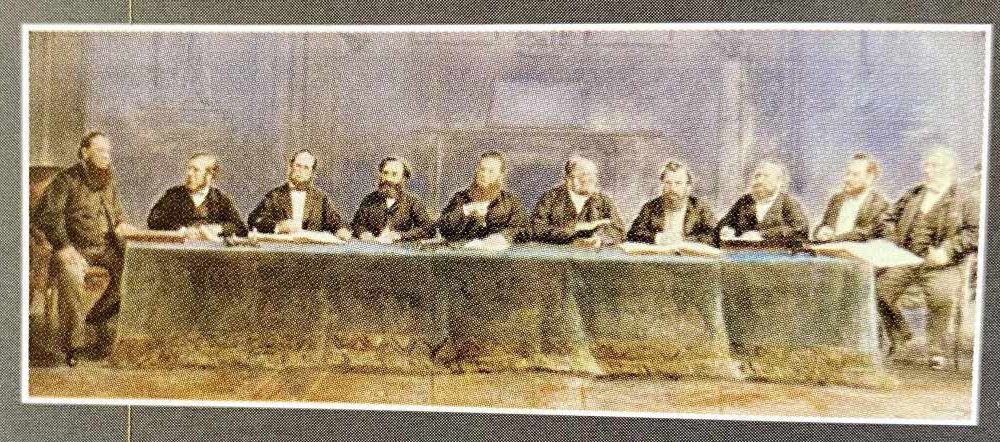Dignity In Poverty
THE FIRST 10 YEARS – 1850 – 1860
INTRODUCTION
Royal Liver Friendly Society (RLFS) was a Friendly Society formed in Liverpool during the mid-Victorian era (July, 1850 to be precise). One of the main catalysts for the creation and formation of Royal Liver was the Irish Potato Famine of the late 1840s. The mass migration of several millions of Irish citizens to west-coast maritime ports like Liverpool substantially increased the population of Liverpool and therefore also directly increased the need for the type of simple Burial Cover which Royal Liver set out to provide for its members/policyholders as a Collecting Friendly Society.
It was reported at the time that …… “In the years between 1845 and 1850, the Parish of Liverpool was becoming overrun by a deluge of destitute Irish people fleeing from their homeland without any means of supporting themselves. The Rector of Liverpool and Chairman of the Select Vestry wrote on several occasions to the Home Secretary, Sir George Grey, seeking relief for the benefit of Liverpool from the Consolidated Fund – but to no avail. It would appear, therefore, that the policy of the Government of the day was to leave the City of Liverpool, and in particular the Parish of Liverpool, to fund the cost of providing relief for these many thousands of immigrants from its’ own resources.”

Royal Liver was a truly unique organisation populated over the years by many quite special personalities and individuals. During its “Glory Years” it possessed and wielded some real financial and economic influence (“heft”) in Great Britain and Ireland.
[A more complete and definitive History of RLFS spanning the 161 years of the Society’s existence 1850 – 2011 is currently in the course of preparation. As and when completed, it is the intention to publish this work on this and related Websites.]
In seeking, effectively, to tell a story about a truly unique organisation and the people which shaped its progress and development across the years, this history of Royal Liver (and extracts from it) will also try to bring to life some elements of the political and social change which has been experienced in the UK and Ireland over the last near 200 years.
Perhaps as with many things, it is best to start at the beginning and so the following pages will deal with Royal Liver’s early years commencing with its formation in Liverpool in 1850.
HUMBLE BEGINNINGS

Royal Liver Friendly Society began life on the evening of July 24, 1850, when a small band of working men met in the Lyver Inn on St. Anne Street in Liverpool. The new Burial Society, which they formed with a small office at 14 Pickop Street, Liverpool, was registered three weeks later on August 14, 1850. It took its name from that first meeting place and was called the Liverpool Lyver Burial Society, with the olde English “Lyver” being quickly replaced with “Liver” shortly after our formal registration.
The founding members all signed their names to Rules of the Society: Thomas Copeland, President; Thomas Holmes, Treasurer; Thomas Mercer, Secretary; John Bates Lawrence, John Wright, and James Hargraves. It is also recorded in the Society’s archives that the first members of the Committee of Management (most, if not all of whom, we have to assume were also the first members of the Society) were T. Copeland, J. Lawton, Jr., J. Lawton, Sr., James Stephenson, Joseph Rimmer, John Wright, and R. Fotheringham.

John Bates Lawrence is recorded as having been “one of the leading lights of the Society” in its early years (1850 – 1860). The Society certainly prospered as a consequence of the drive and determination of John Bates Lawrence and colleagues like him during its first few years. Within only a comparatively short period of time after its establishment in Liverpool in 1850, Royal Liver had opened Offices in all parts of the British Isles, including “the island of Ireland”.

Despite the drive and energy which John Bates Lawrence must have brought to the early development of Royal Liver he was dismissed from the organisation (by his other colleagues on the Board of Directors) during 1861 following a management disagreement which need not concern us now. John Bates Lawrence was clearly not somebody to let this comparative setback deter him from continuing to lead a full and interesting life and the Society’s records reveal that, a few years after 1861, he emigrated to New Zealand where he died in 1904. He was laid to rest in Waikumete Cemetery, near Auckland. The departure of John Bates Lawrence led to a new regime taking effect at Royal Liver from 1861 until the 1880s and this period will be dealt with in a separate blog post.
